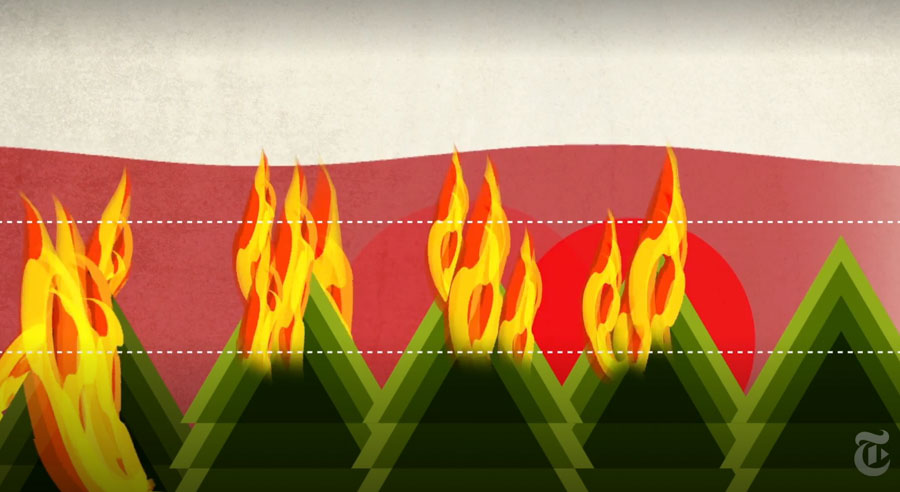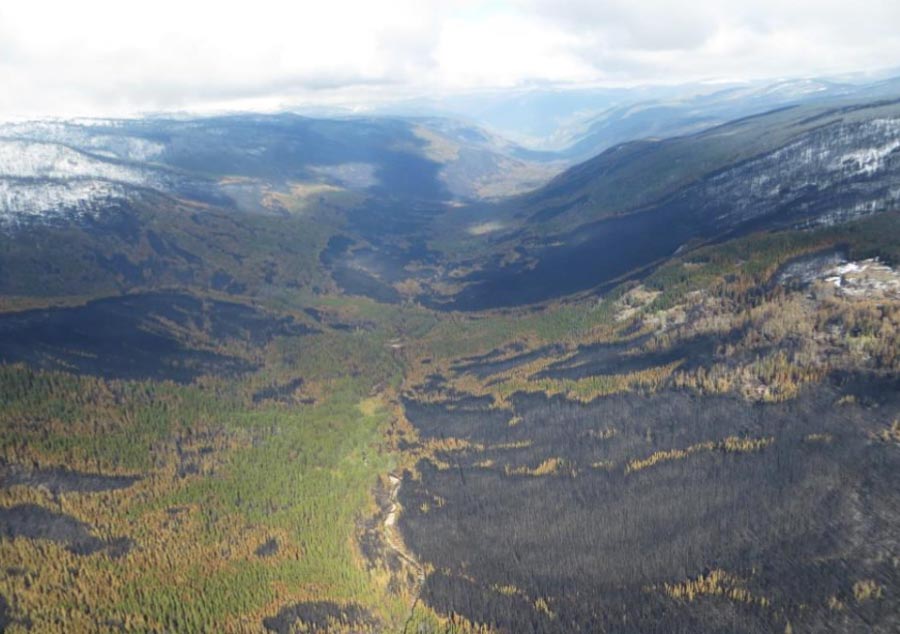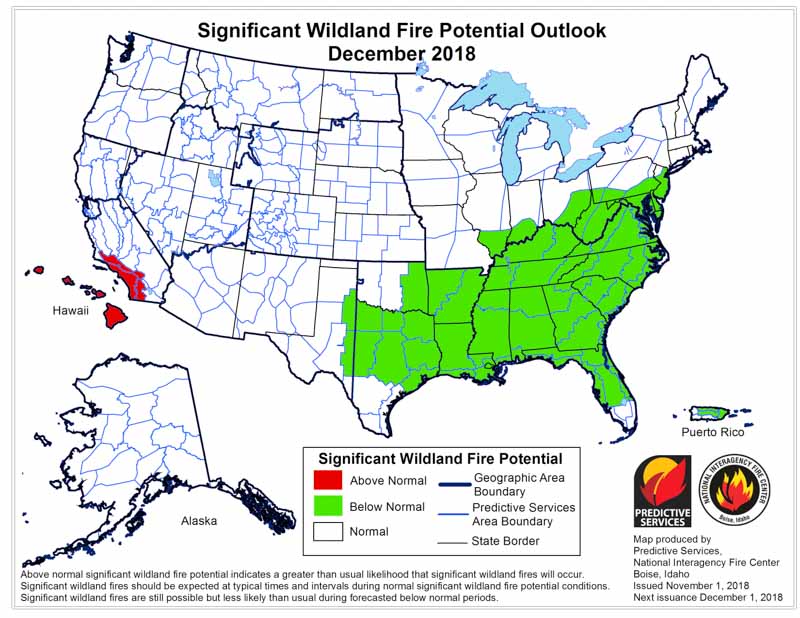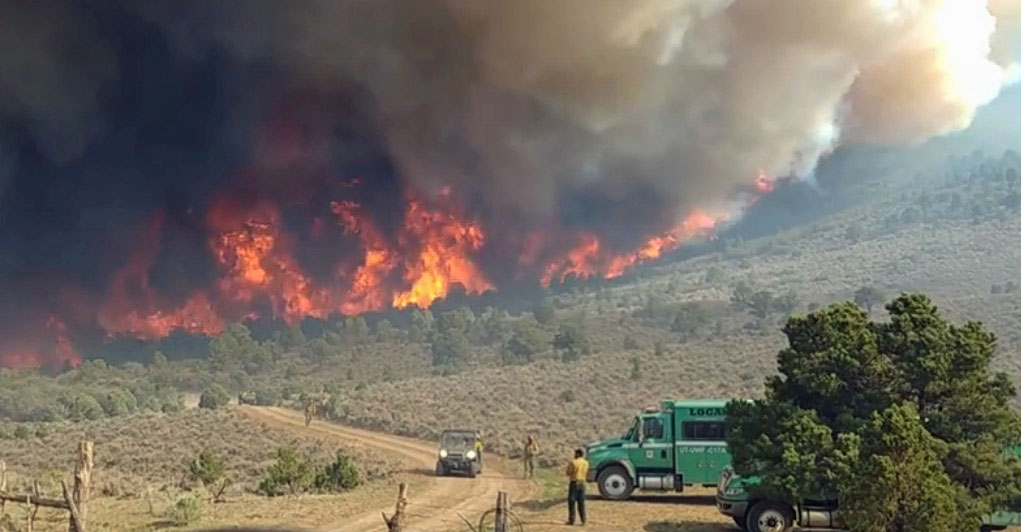
The New York Times produced this quick explanation of how wildfires ignite, spread, and are suppressed.
News and opinion about wildland fire

Researchers studying how wildfires have burned at a particular location found that subsequent fires have a “memory” that helped to self-regulate fire sizes and fire severity. When historical fires burned unabated, landscape patterns of surface and canopy fuels developed that provided barriers to future fire spread. Those same barriers can continue to influence the spread of additional fires.
Susan Prichard and Paul Hessburg were the principal investigators on the “Reburn Project” for the Joint Fire Science Program. They developed a paper, “Evaluating the influence of prior burn mosaics on subsequent wildfire behavior, severity, and fire management options”.
Here are some additional highlights from their findings:
The Reburn Project was motivated by a need to better understand wildfires as fuel reduction treatments and to assess the impacts of decades of wildland fire suppression activities on forested landscapes. The study examined three areas, located in the inland Pacific Northwest, central Idaho and interior British Columbia. Each area had experienced a recent large wildfire event in montane forests.
Reburn Highlights
Above: Spring Creek Fire southwest of Pueblo, Colorado. Photo uploaded to InciWeb June 29, 2018.
Reporters at a recently created newspaper in Colorado dug up a great deal of information about the cost of the large wildfires that occurred in Colorado this year. Jennifer Brown and Jason Blevins authored an article in The Colorado Sun that broke down many different categories of costs, from portable toilets to firefighting aircraft.
The data they collected came from the Colorado Division of Fire Protection and Control. A federal agency has not responded to a records request the newspaper filed months ago.
The article concentrates on two of the largest fires in Colorado this year — Spring Creek 51 miles southwest of Pueblo, and Silver Creek near Kremmling.
Below is an excerpt from the article:
The drought-ravaged summer of 2018 was an expensive one for firefighting, with costs reaching an estimated $130 million for 18 fires, according to documents received by The Colorado Sun through a public records request to the state Division of Fire Protection and Control. Of that, the state’s share is more than $40 million.
That’s six times more than Colorado spent on fighting wildfires in 2017 and two and a half times what it spent in 2016. Ten fires last year cost just more than $10 million combined.
It is a very interesting well researched article –worth your time.
The Colorado Sun published their first edition on September 10. Many of the reporters came from the Denver Post and other newspapers that have had massive staff reductions in recent years. The Post, created in 1892, was purchased in 2010 by hedge fund Alden Global Capital, run by Heath Freeman under their Digital First Media umbrella. The organization has purchased 97 newspapers.
Below is an excerpt from an article published in Bloomberg March 26:
…But what sets Freeman apart is that he seems to have a rather unique view of a newspaper’s purpose. In this view, his papers are intended not so much to inform the public or hold officialdom to account, but to supply cash for Freeman to use elsewhere. His layoffs aren’t just painful. They are savage.
For instance, according to figures compiled by the NewsGuild, the union that represents workers at Digital First Media properties, the staff of the Denver Post has fallen from 184 journalists to 99 between 2012 and 2017. The Pottstown Mercury in Pennsylvania went from 73 journalists in 2012 to 19 in 2017. That’s right: 19. The Norristown Times-Herald, also in Pennsylvania, shrank from 45 journalists to 12. The San Jose Mercury News and the Orange County Register, both of which had been dominant papers in their regions before Alden Global bought them, have also been decimated by layoffs.
[…]
But the pattern continues. Last week, no sooner had Digital First Media closed on its purchase of the Boston Herald than it announced that it would cut the staff from 240 employees to 175.
Thanks and a tip of the hat go out to Tom.
Typos or errors, report them HERE.
On November 1 the Predictive Services section at the National Interagency Fire Center issued their Wildland Fire Potential Outlook for November through February. The data represents the cumulative forecasts of the ten Geographic Area Predictive Services Units and the National Predictive Services Unit.
If their analysis is correct, the only areas with above normal wildfire activity during the period will be Southern California in November and December, and Hawaii December through February.
Below:
“Much of the West exited fire season by early October as the frequency of wet systems moving across the country increased. Cooler temperatures brought higher humidity levels and good overnight recoveries which also reduced large fire potential. As anticipated, the frequency of Santa Ana and North Wind events across California was lower than average, so critical fire weather periods were infrequent and of short duration. Nevertheless, fire activity was observed in isolated locations across the region in the remaining pockets where fuels remained critically dry. The Klondike fire made large runs mid-month. In the East, fire activity was also less active than average. This was due to the onset of a weak El Niño which promoted wetter than average conditions. The primary draw on resources was in response to Hurricane Michael which made landfall at Mexico Beach, Florida, with 155 mph winds.
“While most regions of the country are out of fire season during November, varying levels of activity are observed across California and the Southeast. The onset of El Niño should allow for a continuance of wetter than average conditions across the Southeast which should limit fire activity. However, pockets of critically dry fuels will persist across California, especially along coastal areas and along the front of the Southern Sierra. These areas will remain susceptible during wind events.
“Climatologically speaking, fire activity during the winter months, December through February, is at a minimum. Areas most susceptible to activity are generally restricted to the southeastern states where periodic increases in fire activity are possible during dry periods until spring greenup begins. However, current data and expected trends in precipitation suggest that large fire potential will be Below Normal in this region. The abundance of moisture should keep fuels in most areas from becoming critically dry. Drought forecasts project that the region should remain mostly free of drought.
“Across the West, overall warmer and drier than average conditions are expected. This should lead to below average snowpack in most mountain locations across the northern tier of the country. Snowpack should trend toward average levels moving south along the Continental Divide as the impacts of the El Niño begin to produce a positive effect on precipitation amounts received.”

Continue reading “Wildfire potential, November through February”
At least 50 fire districts support ballot measures in November 6 election to stabilize tax receipts

In Colorado the effects of multiple constitutional amendments have combined, resulting in unintended consequences that have repeatedly reduced tax receipts for fire districts. Automatic changes in the tax rates will continue unless voters, county by county, approve ballot measures on November 6.
Below is an excerpt from The Journal:
Under the Gallagher [Constitutional] Amendment, 45 percent of the total amount of state property tax collected must come from residential property, and 55 percent of the property tax collected must come from commercial property.
The amendment mandates that the assessment rate for commercial property, which is responsible for 55 percent of the total state property tax burden, be fixed at 29 percent. The residential rate, on the other hand, is annually adjusted to hold the 45/55 split constant.
Because of skyrocketing home values on the Front Range, the residential tax rate was dropped statewide to stay within Gallagher’s ratio requirements. In Montezuma County, the residential tax rate recently dropped from 7.9 percent to 7.2 percent and is expected to drop further to 6 percent in 2019.
As home values continue to rise, the tax rates on residences automatically decrease, resulting in shrinking budgets for fire districts.
Another Constitutional amendment, the Taxpayers Bill of Rights, mandates that the property tax rate can’t change without voter approval.
On next week’s ballot is a third amendment, Amendment 73, a very complex tax measure. If it passes, according to The Business Times, it “will fund schools by funneling property tax revenues away from fire departments and other special districts’ budgets to give it to schools.”
What 50 fire districts in 20 counties in Colorado are hoping is that in next week’s election voters in each county will approve ballot measures that will stabilize fire protection funding. With the previous tax receipt reductions, and more expected in the next few years, many fire districts are in dire financial straits and worry that they will have to lay off firefighters and close fire stations.
From the Summit Daily: “Our budgets have been dropping for a long time,” said Jeff Berino, fire chief at Summit Fire & EMS. “Every two years we’ve been seeing less income. We’ve absorbed the hits over the years, but it’s time to draw a line in the sand.”
And it will only get worse unless voters can be convinced that this complex situation needs to be fixed and approve the ballot initiatives on Tuesday.
The video below, posted by the Rocky Mountain Fire District, explains the interaction between two Colorado constitutional amendments (Gallagher and Taxpayers Bill of Rights) and the effect on fire departments in the state.
This is a complex situation that can’t be easily and quickly explained. Some voters might be scared into not approving the ballot measures, hearing that they have something to do with taxes. Firefighters have their work cut out for them to communicate the message that the ongoing automatic reductions in tax revenue for the fire districts need to be reversed and stabilized. If that does not happen, they may be forced into implementing drastic cuts in fire and emergency services.
All three of these Colorado constitutional amendments, crafted with insufficient thought, work together in ways that are unintended, with very severe and negative effects on fire districts.